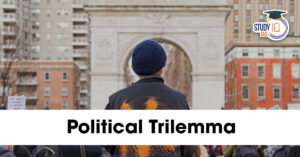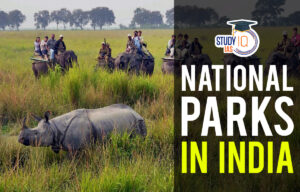Daily Quiz 4 July 2024
Quiz-summary
0 of 5 questions completed
Questions:
- 1
- 2
- 3
- 4
- 5
Information
- Click on – ‘Start Quiz’ button
- Solve Questions
- Click on ‘Next’ button
- Click on ‘Finish Quiz’ button
- Now click on ‘View Questions’ button – here you will see solutions and links.
- The test contains a total of 5 questions.
- Click on the most appropriate option to mark it as your answer.
- You will be awarded Two marks for each correct answer.
- You can change your answer by clicking on some other option.
- A Number list of all questions appears at the top side of the screen.
- You can access the questions in any order by clicking on the question number given on the number list.
- You can use rough sheets while taking the test.
- Do not use calculators, log tables, dictionaries, or any other printed/online reference material during the test.
- Do not click the button “Finish Quiz” before completing the test. A test once submitted cannot be resumed.
You have already completed the quiz before. Hence you can not start it again.
Quiz is loading...
You must sign in or sign up to start the quiz.
You have to finish following quiz, to start this quiz:
- 1
- 2
- 3
- 4
- 5
- Answered
- Review
-
Question 1 of 5
1. Question
1 points1. A population census provides a snapshot of a community at a particular moment in time. Consider the following statements with respect to the census operations in India:
1. In 1872 AD, the first Census was done in India under the rule of Lord Mayo.
2. Presently, the office of the Registrar General and Census Commissioner, under the Ministry of Home Affairs, conducts the decennial census.
3. The Census of India Act of 1948 provides the legal framework and specifies the timing and periodicity of the census.
4. The census of 2011 marked the 15th and the latest census of Independent India.
Which of the statements given above is/are correct?Correct
Explanation:
• Statements 1 and 2 are correct: The decennial census of India, initiated by Viceroy Lord Mayo in 1872, has been a regular occurrence every 10 years, with the first comprehensive census conducted in 1881. The Office of the Registrar General and Census Commissioner, under the Ministry of Home Affairs, conducts the decennial census. Prior to 1951, the Census Organisation was established on an ad-hoc basis for each census.
• Statements 3 and 4 are incorrect: The Census of India Act of 1948 provides the legal basis for conducting the census. However, the Act does not specify the timing or frequency of the census. The 2011 census was the most recent, with the subsequent one scheduled for 2021 postponed due to the COVID-19 pandemic.The Census of India 2011 was conducted in two stages: House listing & Housing Census from April to September 2010, and Population Enumeration from 9th to 28 February 2011. It marked the 15th Census of India and the 7th Census of Independent India, commencing on 1st April 2010, with the President of India being the first citizen enumerated, followed by the Vice President.Incorrect
Explanation:
• Statements 1 and 2 are correct: The decennial census of India, initiated by Viceroy Lord Mayo in 1872, has been a regular occurrence every 10 years, with the first comprehensive census conducted in 1881. The Office of the Registrar General and Census Commissioner, under the Ministry of Home Affairs, conducts the decennial census. Prior to 1951, the Census Organisation was established on an ad-hoc basis for each census.
• Statements 3 and 4 are incorrect: The Census of India Act of 1948 provides the legal basis for conducting the census. However, the Act does not specify the timing or frequency of the census. The 2011 census was the most recent, with the subsequent one scheduled for 2021 postponed due to the COVID-19 pandemic.The Census of India 2011 was conducted in two stages: House listing & Housing Census from April to September 2010, and Population Enumeration from 9th to 28 February 2011. It marked the 15th Census of India and the 7th Census of Independent India, commencing on 1st April 2010, with the President of India being the first citizen enumerated, followed by the Vice President. -
Question 2 of 5
2. Question
1 pointsA population census provides a snapshot of a community at a particular moment in time. Consider the following statements with respect to the census operations in India:
- In 1872 AD, the first Census was done in India under the rule of Lord Mayo.
- Presently, the office of the Registrar General and Census Commissioner, under the Ministry of Home Affairs, conducts the decennial census.
- The Census of India Act of 1948 provides the legal framework and specifies the timing and periodicity of the census.
- The census of 2011 marked the 15th and the latest census of Independent India.
Which of the statements given above is/are correct?
Correct
Answer: A
Explanation:
- Statements 1 and 2 are correct: The decennial census of India, initiated by Viceroy Lord Mayo in 1872, has been a regular occurrence every 10 years, with the first comprehensive census conducted in 1881. The Office of the Registrar General and Census Commissioner, under the Ministry of Home Affairs, conducts the decennial census. Prior to 1951, the Census Organisation was established on an ad-hoc basis for each census.
- Statements 3 and 4 are incorrect: The Census of India Act of 1948 provides the legal basis for conducting the census. However, the Act does not specify the timing or frequency of the census. The 2011 census was the most recent, with the subsequent one scheduled for 2021 postponed due to the COVID-19 pandemic.The Census of India 2011 was conducted in two stages: House listing & Housing Census from April to September 2010, and Population Enumeration from 9th to 28 February 2011. It marked the 15th Census of India and the 7th Census of Independent India, commencing on 1st April 2010, with the President of India being the first citizen enumerated, followed by the Vice President.
Incorrect
Answer: A
Explanation:
- Statements 1 and 2 are correct: The decennial census of India, initiated by Viceroy Lord Mayo in 1872, has been a regular occurrence every 10 years, with the first comprehensive census conducted in 1881. The Office of the Registrar General and Census Commissioner, under the Ministry of Home Affairs, conducts the decennial census. Prior to 1951, the Census Organisation was established on an ad-hoc basis for each census.
- Statements 3 and 4 are incorrect: The Census of India Act of 1948 provides the legal basis for conducting the census. However, the Act does not specify the timing or frequency of the census. The 2011 census was the most recent, with the subsequent one scheduled for 2021 postponed due to the COVID-19 pandemic.The Census of India 2011 was conducted in two stages: House listing & Housing Census from April to September 2010, and Population Enumeration from 9th to 28 February 2011. It marked the 15th Census of India and the 7th Census of Independent India, commencing on 1st April 2010, with the President of India being the first citizen enumerated, followed by the Vice President.
-
Question 3 of 5
3. Question
1 pointsWhat is Pushpak recently seen in news?
Correct
Answer: D
Explanation:
Option (d) is correct: The Indian Space Research Organisation (ISRO) accomplished the third landing experiment of the Reusable Launch Vehicle (RLV LEX-03) named ‘Pushpak’. Pushpak is India’s futuristic Reusable Launch Vehicle. The rocket’s name is inspired by the ‘Pushpak Viman’ from the Ramayana, known as the Vehicle of Kuber, the Lord of Wealth. It is designed as an all-rocket, fully reusable single-stage-to-orbit (SSTO) vehicle. Pushpak incorporates several major elements, including the X-33 advanced technology demonstrator, the X-34 testbed technology demonstrator, and the upgraded DC-XA flight demonstrator. Pushpak could eventually refuel in-orbit satellites or retrieve satellites from orbit for refurbishment. It is a step towards India’s aim of “minimising space debris.” Pushpak sets the stage for establishing the Bhartiya Antariksh Station by 2035.
Incorrect
Answer: D
Explanation:
Option (d) is correct: The Indian Space Research Organisation (ISRO) accomplished the third landing experiment of the Reusable Launch Vehicle (RLV LEX-03) named ‘Pushpak’. Pushpak is India’s futuristic Reusable Launch Vehicle. The rocket’s name is inspired by the ‘Pushpak Viman’ from the Ramayana, known as the Vehicle of Kuber, the Lord of Wealth. It is designed as an all-rocket, fully reusable single-stage-to-orbit (SSTO) vehicle. Pushpak incorporates several major elements, including the X-33 advanced technology demonstrator, the X-34 testbed technology demonstrator, and the upgraded DC-XA flight demonstrator. Pushpak could eventually refuel in-orbit satellites or retrieve satellites from orbit for refurbishment. It is a step towards India’s aim of “minimising space debris.” Pushpak sets the stage for establishing the Bhartiya Antariksh Station by 2035.
-
Question 4 of 5
4. Question
1 pointsConsider the following statements with respect to the Parliamentary Oath taking process in India:
- Members of Parliament must take the parliamentary oath to participate in debates and vote in the Lok Sabha.
- The constitution of India prescribes the oath or affirmation to be taken by the MPs.
Which of the statements given above is/are correct?
Correct
Answer: C
Explanation:
- Statements 1 and 2 are correct: The oath-taking ceremony typically happens soon after the election results are declared. MPs must take the parliamentary oath to participate in debates and vote in the Lok Sabha. The oath or affirmation is prescribed in the Constitution (Article 99), with a financial penalty of Rs 500 for participating in proceedings without taking the oath (Article 104). It Includes allegiance to the Constitution, upholding India’s sovereignty and integrity. MPs can take oath in English or any of 22 specified languages. MPs in jail can take oath to avoid seat being declared vacant after 60 days. There exists personal choice between oath (in God’s name) and affirmation.
Incorrect
Answer: C
Explanation:
- Statements 1 and 2 are correct: The oath-taking ceremony typically happens soon after the election results are declared. MPs must take the parliamentary oath to participate in debates and vote in the Lok Sabha. The oath or affirmation is prescribed in the Constitution (Article 99), with a financial penalty of Rs 500 for participating in proceedings without taking the oath (Article 104). It Includes allegiance to the Constitution, upholding India’s sovereignty and integrity. MPs can take oath in English or any of 22 specified languages. MPs in jail can take oath to avoid seat being declared vacant after 60 days. There exists personal choice between oath (in God’s name) and affirmation.
-
Question 5 of 5
5. Question
1 pointsConsider the following cities:
- Jaipur
- Mysore
- Srinagar
- Lucknow
How many of the above cities of India have been recognized as a ‘World Craft City’ by the World Craft Council (WCC)?
Correct
Answer: C
Explanation:
- Option (c) is correct: Srinagar has become the fourth Indian city to be recognized as a ‘World Craft City’ by the World Craft Council (WCC), three years after it was designated as part of the UNESCO Creative City Network (UCCN) for crafts and folk arts. Srinagar is the 4th Indian city to be designated a World Craft City, joining Jaipur, Malappuram, and Mysore. World Crafts Council is a Kuwait-based organisation dedicated to the recognition and preservation of traditional crafts globally. It recognizes the crucial role of local authorities, craftspeople, and communities in driving cultural, economic, and social development globally.
- Jaipur: Known for Kundan Jadai (gem setting), Meenakari jewellery, Lac-based crafts, and Gotta Patti work.
- Mysuru: Famous for Kinnal paintings, Sandalwood carvings, and Rosewood inlay work.
Mamallapuram: Renowned for stone carving, a tradition dating back to the Pallava dynasty (275 CE to 897 CE).
Incorrect
Answer: C
Explanation:
- Option (c) is correct: Srinagar has become the fourth Indian city to be recognized as a ‘World Craft City’ by the World Craft Council (WCC), three years after it was designated as part of the UNESCO Creative City Network (UCCN) for crafts and folk arts. Srinagar is the 4th Indian city to be designated a World Craft City, joining Jaipur, Malappuram, and Mysore. World Crafts Council is a Kuwait-based organisation dedicated to the recognition and preservation of traditional crafts globally. It recognizes the crucial role of local authorities, craftspeople, and communities in driving cultural, economic, and social development globally.
- Jaipur: Known for Kundan Jadai (gem setting), Meenakari jewellery, Lac-based crafts, and Gotta Patti work.
- Mysuru: Famous for Kinnal paintings, Sandalwood carvings, and Rosewood inlay work.
Mamallapuram: Renowned for stone carving, a tradition dating back to the Pallava dynasty (275 CE to 897 CE).
Results
0 of 5 questions answered correctly
Your time:
Time has elapsed
You have reached 0 of 0 points, (0)
| Average score |
|
| Your score |
|
Categories
- Not categorized 0%
| Pos. | Name | Entered on | Points | Result |
|---|---|---|---|---|
| Table is loading | ||||
| No data available | ||||
Sharing is caring!

 Political Trilemma Concept and Crisis in...
Political Trilemma Concept and Crisis in...
 List of National Parks in India 2025, Ch...
List of National Parks in India 2025, Ch...
 Lipids, Types, Structure and Examples
Lipids, Types, Structure and Examples





















